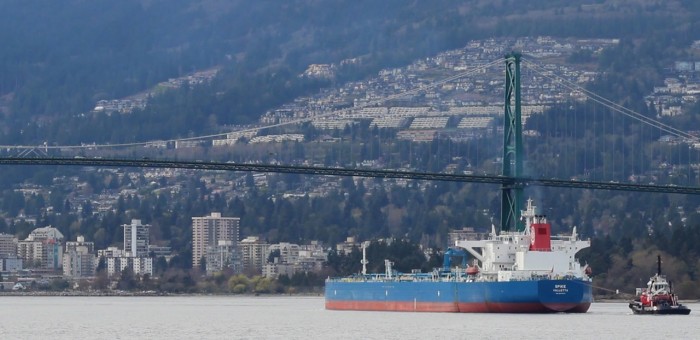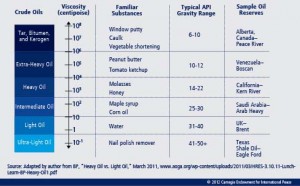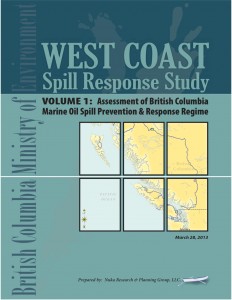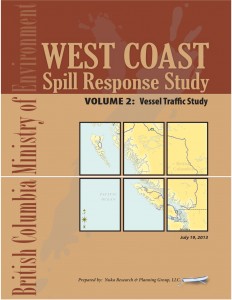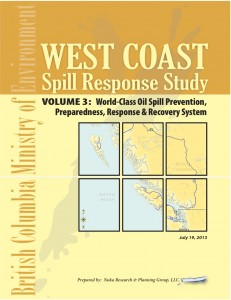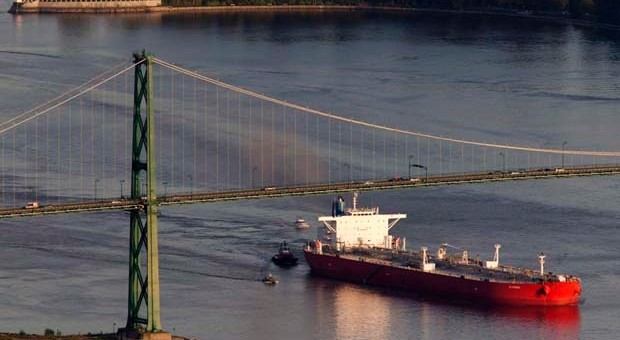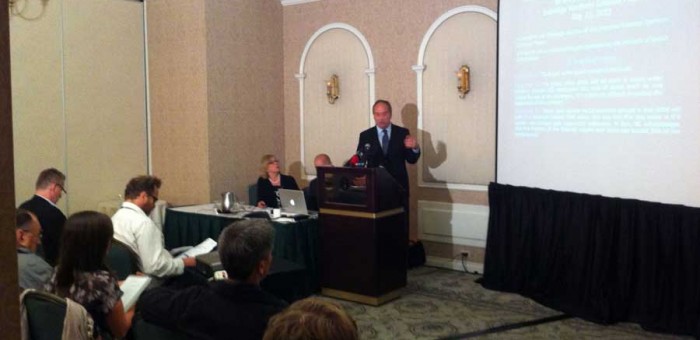Enbridge
Heavy Oil Pipelines: Background
With the development of the Alberta oil sands, the Federal government and stakeholders in the oil sands industry have been looking for new heavy oil export opportunities. One path that is under consideration is to transport heavy oil across British Columbia for shipment by tanker to international refineries.
There are two major heavy oil pipeline proposals that are being considered in British Columbia. The first is the Northern Gateway Pipeline, proposed by Enbridge. This pipeline would run 1,177km from Northern Alberta to the port of Kitimat, B.C. and would transport up to 525,000 barrels of heavy oil per day. The second proposal is an expansion of Kinder Morgan’s existing Trans Mountain Pipeline, which runs 1,150 km from Strathcona Country, AB, to Burnaby, BC. The expansion would increase the carrying capacity of the pipeline from 300,000 barrels per day, to 890,000 barrels per day.
One of the key concerns with these pipeline projects is that the type of oil that will be transported is not traditional crude oil. Instead, the heavy oil that would be transported is called “diluted bitumen” or “dilbit”. Bitumen by itself is very viscous (like window putty, caulk or vegetable shortening) and so does not flow through pipes. As such, it is mixed with condensates (other very light hydrocarbons) with an API (American Petroleum Institute) gravity range of typically >50 (see Figure 1). Unlike traditional crude oils, bitumen is heavier than water that, by definition, has an API gravity equal to 10 (see Figure). What this means is whereas traditional crude oil will largely float on the surface of the ocean in the event of a spill, up to 50% of dilbit would sink (particularly in the presence of suspended particles in the water column), making it much more difficult to clean up. Traditional oil spill recovery techniques will not work nearly as effectively on dilbit and our current knowledge of what happens to the portion of dilbit that sinks is severely limited. One therefore needs to make a clear distinction between dilbit and other crude oils.
Figure 1: Typical density of a variety of oils characterized using the American Petroleum Institute (API) gravity scale. Water is measured as 10 so numbers <10 are heavier than water and numbers >10 are lighter than water. Source: http://carnegieendowment.org/2012/12/18/carbon-contained-in-global-oils/euzi#
In response to the public backlash against these pipeline projects, the Liberal government announced 5 conditions that will guide BC’s approval of any new heavy oil pipeline. The conditions are as follows:
1. Successful completion of the formal environmental review processes.
2. World-leading marine oil spill response, prevention and recovery systems for British Columbia.
3. World-leading practices for land spill prevention, response and recovery systems for British Columbia.
4. Legal requirements regarding Aboriginal and treaty rights must be addressed and First Nations be provided with the opportunities to benefit from these projects.
5. British Columbia receives a fair share of the fiscal and economic benefits of proposed heavy oil projects that reflect the risk borne by the province.
The BC government, however, has yet to outline the specific criteria that it will use to evaluate the extent to which these conditions are met. For instance, what is the maximum allowable response time to a spill under condition three? Or what percentage of heavy oil must be recovered from a marine spill to satisfy condition two? Nevertheless, the BC government has released three comprehensive reports providing: 1) an Assessment of British Columbia Marine Oil Spill Prevention & Response Regime; 2) a past and potential future Vessel Traffic Study; 3) an assessment of what one World-Class Oil Spill Prevention, Preparedness, Response & Recovery System might look like.
Figure 2: Three volumes of the West Coast Spill Response Study (click on image to load report).
In addition to the environmental considerations, there are also economic questions that have yet to be fully addressed. Could British Columbia, Alberta and Canada more generally benefit more from refining the oil here at home, rather than simply selling off our raw resources?
The Joint Review Panel that has been considering the Northern Gateway proposal is due to submit its report to the Federal Government in December 2013. Meanwhile, Kinder Morgan is currently finalizing its submission to the National Energy Board for the Trans Mountain Pipeline Expansion project. Once the assessments are completed, it will be up to the Federal Government to decide whether or not to approve the projects.
Open Letter to Premier Christy Clark
“We are woefully under-resourced,” Clark said in a recent interview with Peter Mansbridge on CBC. This in response to both internal and public reports that British Columbia is unable to respond to an oil spill along the coast, and certainly does not have the techniques, equipment or expertise to manage a diluted bitumen (DilBit), or heavy oil, disaster.
Meanwhile, the Premier is actively seeking revenue guarantees for any heavy oil pipeline originating from Alberta, sending a mixed message to industry, developers and communities. On one hand the fact neither provincial or federal resources will be able to handle even a relatively small marine spill would seem to be a line in the sand – no pipelines, no tankers. On the other hand, smiles and handshakes with Alberta Premier Alison Redford with words suggesting the provinces are closer to a revenue agreement.
Before the province continues down a path of dilbit transport, here are four questions that need to be answered.
An Open Letter to Premier Christy Clark
October 9th,2013
Honourable Christy Clark Premier of British Columbia
Parliament Buildings Victoria BC V8V 1X4
Dear Premier Clark:
I applaud the fact that your government has been consistent in requiring five conditions to be met before you will support enhanced heavy oil tanker traffic off our coast. Consistency is important in providing certainty to the public, business and investors alike. It is for this reason that I am writing to you to seek some further clarification on the second and third of your five conditions. As written, these conditions require:
“World-leading marine oil-spill response, prevention and recovery systems for B.C.’s coastline and ocean to manage and mitigate the risks and costs of heavy-oil pipelines and shipments.”
“World-leading practices for land oil spill prevention, response and recovery systems to manage and mitigate the risks and costs of heavy oil pipelines.”
The Department of Fisheries and Oceans has identified that behaviour models specific to diluted bitumen (dilbit) do not exist. In short neither research nor data on the effects of dilbit released into a marine environment is available. In addition, the procedures, protocols, equipment and expertise that will be required to respond to a potential spill do not exist. This suggests that the current standard for a “world-leading” response is, practically speaking, a fairly low standard.
In my view, the Province’s May 31, 2013 thorough and comprehensive submission to the Joint Review Panel (JRP) did an outstanding job representing the interests of British Columbians. The submission specifically stated that the BC Government required an “effective” heavy oil spill response capacity before it could support a proposal. In that report, the government implies that its criteria for an “effective response” includes meeting specific standards for:
1. Removing dissolved oil from the water column;
2. Dealing with sunken oil in a water course;
3. Implementing a precise leak detection threshold;
4. Committing to a specific and realistic response time to any oil spill at any affected geographic location;
5. Ensuring accessibility of the pipeline year-round to respond to any spill, regardless of seasonal conditions.
In order to provide further clarity to the public, business and investors I have four further questions:
1) Could you please provide a detailed outline of the specific standards and criteria your government uses to evaluate the effectiveness of a proposal’s heavy oil spill response capacity?
2) In your interview with Peter Mansbridge that aired on October 5, 2013, you stated that British Columbia is “woefully under-resourced” to deal with a heavy oil spill. You also acknowledged that BC is already at risk of a heavy oil spill, since tankers leave Burnaby harbour every week transporting dilbit from the Kinder Morgan Trans Mountain pipeline. As I am sure you are aware, the product transported in the Trans Mountain pipeline has changed since it was initially constructed in 1963 and dilbit is a relatively new addition. Given the numerous concerns that you and your government have raised about our current heavy oil spill response capacity, will the proposals to expand the Trans Mountain pipeline or transport heavy oil by rail be subjected to the same specific criteria of “effectiveness” that you have laid out for the Northern Gateway proposal?
3) In this same interview you made it clear that you expect the federal government to provide more resources for marine spill response “before any more heavy oil comes off the coast”. However, the Province’s submission to the JRP clearly states that an effective spill response will “be impossible or severely constrained” in certain regions, regardless of available resources. How, realistically, will further Federal resources address the fact that effective spill response may not even be possible in certain instances?
4) In regards to the heavy oil that is already being transported out of Burnaby harbour as well as any additional heavy oil that is to be transported to the BC coast, would you not agree that it would make far more sense to refine that heavy oil in its entirety in British Columbia prior to shipping it offshore both to mitigate against the risk of a marine dilbit spill and to provide jobs and an economic stimulus to British Columbia?
I thank you in advance for your consideration of these four questions and I very much look forward to your response.
Yours sincerely
Andrew Weaver
.
No Means No, Not a Pathway to Yes on Northern Gateway
In a press conference on September 4th, Elizabeth May MP (Saanich and Gulf islands) and Andrew Weaver MLA (Oak Bay – Gordon Head) presented information that the federal government is moving forward with a Kitimat region research program, while the BC government has said no to the Northern Gateway Project.
The Federal Government is moving forward over the next two years with a $100 million plus, ‘Complementary Measures Project’ (now called ‘World Class’) to research and model the complex waterways in the Kitimat and Hecate Straights region. In essence this is a federal government subsidy to the Northern Gateway Project, as they are unable to satisfy basic safety, environmental and regulatory requirements. In fact documents from the Department of Fisheries and Oceans identified that: “Behaviour models specific to dilbit spills do not exist, and existing commercial models for conventional oil do not allow parameter specific modifications.”
On the federal level contrary to what Stephen Harper has said about awaiting the evidence and panel results, the Government of Canada has been pushing ahead with spending over $100 million to support what should be industry based research. This comes at a time of major cuts to science funding for climate change, marine contaminants and ELA.
In its thorough submission to the Northern Gateway Joint Review Panel the British Columbia Government stated: “the Province is not able to support approval of the project, and submits that its concerns respecting NG’s ability to respond to a spill should be given serious consideration by the JRP”. Should a spill occur, the research, data and evaluation of the effects of diluted bitumen (dilbit) on both land, fresh water and marine environments are simply not available, neither are the procedures, protocols, equipment and expertise that will be required to respond.

